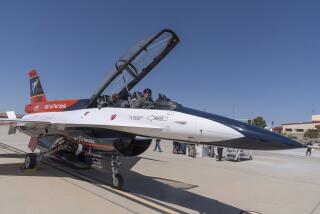Beyond Visual Range: Risk High With Aegis System
- Share via
Although U.S. warships in the Persian Gulf are operating in close proximity to heavy commercial and private air traffic, Pentagon experts have known for years that weapons systems designed to shoot down enemy aircraft sight unseen have never had a sure-fire way of identifying potential targets.
As a result, these weapons systems--including the ultra-sophisticated Aegis system that was involved in the destruction of an Iranian commercial airliner Sunday--were known to carry enormous risks that U.S. forces one day would accidentally destroy civilian planes or their own jets.
The destruction of the Iranian airliner with the loss of 290 people by the cruiser Vincennes fulfilled the worst fears of critics who have long maintained that the United States was spending billions of dollars on exotic weapons of dubious technical capability.
The Aegis system was designed to fight a major naval battle against the Soviet Union in the open ocean, operating as part of a large aircraft carrier battle group. It was never intended to go solo in a closed area like the Persian Gulf, aboard a neutral warship guarding commercial sea lanes.
Critics say that the Pentagon has put too much emphasis on developing “push-button” weapons that rely on high technology to conduct combat “beyond visual range.”
“BVR,” referring to a form of conflict in which soldiers would fight at long ranges with an array of high-technology weapons, has become a buzzword in the military services and the defense industry.
“This incident raises the question of whether this equipment has the precision to do what is claimed,” said John Boyd, a retired Air Force weapons designer who championed the F-16 jet fighter. “Do we really have a ‘beyond visual range’ capability? I mean, when we shoot at somebody, is it really who we intended to shoot down?”
In the case of Navy ships at least, the impetus for developing BVR weapons has come in part from the allure of advancing technology and in part from a cruel dilemma facing surface ships: Although identification systems are imperfect, ships have become highly vulnerable to air-to-ship missiles such as the French Exocet, which can be launched with devastating effect before the planes carrying them are visible to the target.
Outside Firing Range
Air Force and Navy doctrine holds that in a major war, long-range weapons would stop enemy aircraft before they could come within firing range of U.S. targets. To that end, the services have developed air-to-air missiles such as the Navy Phoenix, which is supposed to shoot down targets at a range of more than 100 miles. The missiles cost nearly $1 million each.
Huge investments, such as that for the billion-dollar Aegis system, have also fueled congressional concern, even before the incident involving the Iran Air Airbus. Rep. Denny Smith (R-Ore.), a frequent critic of the Aegis system, said that, despite technological advances, the only certain way to identify targets is to send fighter pilots to see for themselves.
In a war using BVR weapons, said Smith, who served as an Air Force pilot during the Vietnam War, “. . . the first time we knock down some of our own guys because we shot them at beyond visual range, I think you would see Air Force doctrine would be to go right back to checking out the individual visually.”
Need for Visual Clues
Indeed, the Pentagon imposed strict requirements that targets be visually identified during the Vietnam War after at least one U.S. combat jet was shot down by “friendly” fire.
Such incidents are supposed to be prevented by equipment--carried by every military airplane and ship--called an “Identification Friend or Foe” system. At best, IFF systems can determine only whether a potential target is a friend, but they can never say whether it is neutral or a foe.
Separately, the Aegis system, which consists of radar, computer processors and display terminals, is supposed to identify enemy aircraft by various unique radio signals they emit. The Navy has only 11 commissioned ships equipped with Aegis, and 16 more are to be built.
“The Aegis system is all automatic, with one exception--identification and recognition” of incoming aircraft, one military expert noted. “Identification is a human decision made by human beings on a variety of factors.”
‘Mundane Necessities’
That “is a problem we should be devoting a lot more attention to,” said Josh Epstein, a research analyst at Brookings Institution in Washington. “It is one of those mundane necessities that doesn’t get a lot of attention or money.”
The problems would be even greater in a major European war. Hundreds of friendly and hostile aircraft would crowd the skies near major battlefields, increasing the likelihood that U.S. forces equipped with BVR weapons would shoot down their own planes.
“You can make a flat statement that that is going to happen,” said Adm. Thomas H. Moorer, former chairman of Joint Chiefs of Staff.
Nonetheless, Moorer and other BVR proponents dismiss the critics, saying that equipping forces with less complex weapons is “no way to send the youth of our land into war.”
The IFF systems intended to deal with the identification problem work by sending an electronic message in a secret code to a target. If the target is friendly, its IFF system will respond with a message in the same secret code. If there is no response, the target is assumed to be non-friendly.
Using Vacuum Tubes
The current IFF system used by the Air Force and Navy is the Mark 12, which is so old that some of its electronic equipment still uses vacuum tubes. It was designed in the mid-1950s and is widely considered obsolete.
“It would be a fair generality to say that the reliability of the Mark 12 is a concern,” said Thomas Fowler, deputy director of the Combat Identification Directorate at the Air Force’s Aeronautical Systems Division. “For a lot of different reasons, the system doesn’t work sometimes. . . . The bottom line is that when the system needs to be used, it doesn’t always work.”
The Air Force began developing a new system in the 1970s known as the Mark 15, but that development is mired in controversy and far behind schedule. The Senate Armed Services Committee is considering whether to continue authorizing development of the system.
Some critics of BVR weapons see more fundamental problems, saying that the entire concept of fighting battles sight unseen is a costly and ineffective policy foisted on the Pentagon by the defense industry.
‘It Doesn’t Work’
“We have been spending billions of dollars every year on BVR, and this Iranian incident is just one more bit of proof that it doesn’t work,” said Tom Amlie, an Air Force analyst and noted military technology expert.
Such long-range weapons also have a poor record of successfully hitting targets during actual combat.
The Standard missile, which downed the Iranian jetliner, has a notably unsuccessful combat record against fighter jets. The missile scored only one successful hit before the Iranian jetliner and that was during the Vietnam War, Amlie said.
Similarly, the Sparrow, an air-to-air BVR missile, also has a troubled history. According to a Congressional Budget Office analysis, the Sparrow scored only seven successful kills in the 1973 Arab-Israeli War, while the short-range Sidewinder scored 200 successes.
Times staff writer John M. Broder in Washington also contributed to this article.
More to Read
Sign up for Essential California
The most important California stories and recommendations in your inbox every morning.
You may occasionally receive promotional content from the Los Angeles Times.










